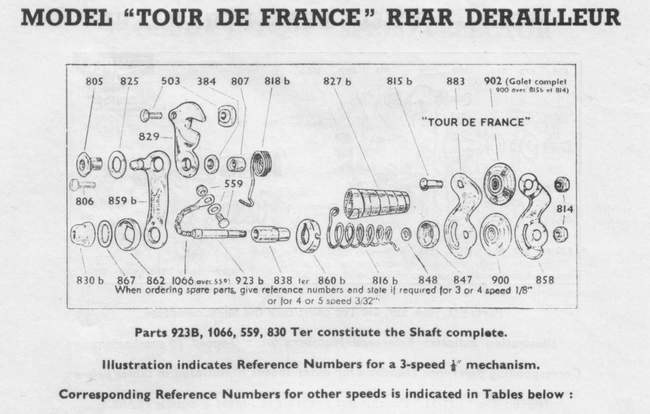Bottom bracket lengths
Posted: Monday 21st September 2020
1. Cottered
When I first started restoring old bikes fitting bottom brackets was very much a process of trial and error. As this could be both frustrating and time consuming I carried out some research to get it right first time.
Chater Lea axles are of superlative quality but not only hard to find but even rarer in anything apart from single speed (no 1615) the wider ones are marked 1615-1 and 1615-2. Confusingly the former being the widest!
Bayliss Wiley are excellent quality and far easier to obtain. My 1962 Holdsworth Aids has a note to the effect that BW had just ceased trading, but there are still stocks and that TDC produce equivalents. My experience with TDC is that there was a major decline in quality to such an extent that unless I can’t get the BW equivalent I won’t use TDC. Having said that TDC did produce some cups marked 0, which stands for oversized and are useful for frames with worn threads.
Until 1953 BW only produce a ngcc (non gear case clearance ie for single sprocket on the rear) axle plus a range for roadster and carrier bikes. Responding to increasing use of gears by British riders they introduced:
– two longer axles
– a featherweight set to compete with continental design(still all steel)
The latter weighed in at 310g some 50g (2oz) lighter than a conventional set. This was mainly achieved by making the axle hollow. The adjusting cup had a hexagonal adjustment and the lockring had 8 notches. Beautifully polished: as good as anything from Europe.
The table below classifies the different cottered axles and hopefully will provide a useful guide to what those numbers mean:
| Model no | TDC equilivent no | Overall length mm | Distance between bearing surfaces | Comments |
| 15 | 4 | 122 | 52 | Often marked ngcc ( non gearcase clearance |
| 23 | 9 | 125.5 | 52 | Single ring with derailleur |
| 14 | 2 | 129 | 52 | Williams etc doubles |
| 8 | none | 135 | 52 | BSA pattern 5 pin doubles eg Stronglight/Gnutti /Milremo etc |
NB No. 22 The 5 pin pattern needs a wider clearance to avoid the chainring bolts rubbing the fixed cup
NB All the axles were available in plain (brown) or polished finish no difference in terms of the bearing surfaces!!!
Ref :
3/53 CTC Gazette Ad for new no. 23 axles
7/53 CTC Gazette Ad for new Featherweight bracket set
2. Cotterless
TA axles for their cranks and 49Ds have a number:
314 single chainring
344 double
373 and 374 triple
I too seem to spend a lot of time juggling with bottom-bracket axles. For example, I decided to upgrade my Flying Scot which had a single Brampton chainset to a double Stronglight/TA cottered set up. I have a very crude way of measuring axles from the inner bearing edge to the outside edge of the crank. I had a note that the Ephgrave with Durax double chainset was 32/36. Checking the existing axle showed it to be 32/34 so I tried 32/36. This nearly worked except that bolts on the inside of the chainring just caught the chainstay. Out with the axle and I eventually found a 34/38 which seemed to do the trick. What I can’t understand is that when I was building bikes in the 50s there were two axles, ‘normal’ and ‘chaincase clearance’ and I wonder when all of these variations came into play.
John Spooner owned a cycle shop and also built his own frames. He is a fount of knowledge on all things lightweight. He explained that as a general rule BB axle BW (Baylis Wiley) 14 is for double and BW 15 for single chainsets. When I got home I looked in the BB box and found a BW23!! I did read, in a Cycling from the late forties, an enquiry asking what length axle to use for these new-fangled double chainsets – the answer from Chater Lea was to use a tandem axle!
This all reminded me that some years ago I was struggling to find an axle of the right length for my road/path Ephgrave which was on fixed, the problem being that the Chater chainset was just a bit too far out for ideal chain alignment which can be critical when using fixed with a ‘rigid’ 1/8” chain. Someone suggested, ‘put the axle in the other way round’ which I did and never had trouble again (it was 32/34) but I guess my left pedal is 2mm too far out!
I was also recently trying to find the correct Stronglight axle for a 5-pin Stronglight/TA setup. The eventual winner was a Number 20 which measures as 120mm overall. I guess the 125mm axle is for a triple chainset as it put the chainline too far out for the double.
Posted: Monday 21st September 2020
Contents
This article appears in the following categories.
Upcoming Events
Whether you are looking for a gentle social meet up, or a 100-mile ride browse the community’s upcoming events and plan your next weekend outing.
